Clothing test: Ten current oilskin sets - a comparison of strengths and weaknesses
Michael Rinck
· 31.03.2024
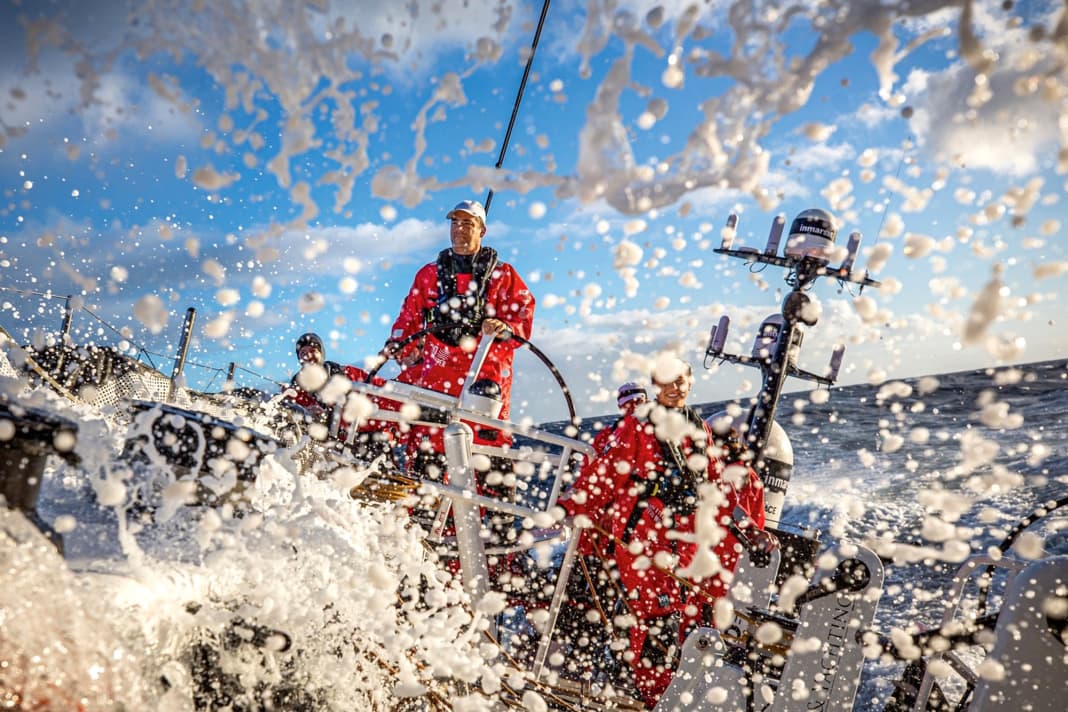





We have tested these sets:
When the spray flies or it rains cats and dogs, the layers of functional clothing help you stay dry and warm. On the skin, the base layer (thermal underwear) in combination with the mid-layer protects against the cold. The outermost waterproof layer consisting of trousers and jacket with close-fitting cuffs and hood acts as a final bulwark against bad weather.
However, the manufacturers also have different clothing for special requirements in their programme. These are usually categorised into inshore, coastal and offshore depending on the area. Inshore sailing clothing (i.e. for coastal and inland areas) is usually very minimalist and may even come without a hood and with a discreet collar. Offshore gear for ocean passages offers much more protection from the elements. The coastal version lies exactly in between. It offers sufficient protection, but is usually still quite light and is also in the mid-range in terms of price. This makes it suitable for sailors who are travelling on day trips during the season.
Coastal oil is not cheap either, with the set price quickly reaching up to 1,000 euros
The price range for Coastal oilskins is quite wide. Jackets and trousers with good functionality are available from as little as 500 euros. Still a lot of money. But there is no way around functional clothing. Even in summer, it can quickly get very cold in bad weather. And protection against the wet is ultimately a preventative measure against hypothermia. Expensive clothing is therefore essential.
Ten sets were included in the test. Almost all of them came from well-known manufacturers in the water sports sector. The only exception is Patagonia with its Big Water Foul Weather product. This is actually an offshore oilskin, but for tropical areas. Unfortunately, the trousers were not available. Otherwise, there was the new OS3 from Gill, Helly Hansen's retro-style Newport, Henri Lloyd with its M-Pro 2.0, and Musto brought both the BR2 (recommended by the manufacturer as a coastal combination) and the lighter LPX. North Sails, a very renowned brand, was a new addition to the candidates, now also with a complete clothing range.
With the Inshore Race and NSX Inshore variants, two lighter station wagons were at the start. Also represented was Typhoon, the oilskin that replaces Plastimo's own brand, which comes from Bukh Bremen in Germany and is traded at 12seemeilen.de. Finally, there was the CST500 from the Australian brand Zhik. Compass, Crazy4Sailing and Seatec were not included in the test, as these manufacturers have not been available since the past test (YACHT 9/2020) there were no new products. Unfortunately, the new oilskins from Marinepool did not arrive in time for the test. There are promising parts from Sailracing, but no designated coastal oilskins. The ten oilskin sets in the test were tried out in a repeatable test set-up. Instead of going on board, we took a shower to simulate rain showers.
On board, according to the conventional wisdom, would be the realistic conditions that should deliver results. However, these results are highly dependent on the prevailing weather. In bright sunshine, for example, there are no usable results at all. In addition, the weather could change during the course of the day, which means that the test conditions would not be constant for all products. This is why we test the functional clothing in a reproducible test setup.
How the oilskin is tested
The main components include a fitting with consistently repeated movement sequences to determine the fit and freedom of movement, as well as a five-minute simulated rain shower in the shower, during which the same movement sequences are also repeated. The hood is tested particularly thoroughly. Tightness as well as comfort and good visibility are crucial here.
The points in the table, which ultimately determine the test winner, were weighted in such a way that waterproofness received the most points at 40. After all, this is the reason for buying an oilskin suit in the first place. This is followed by wearing comfort with 30 points. The fit and visibility of the hood were also assessed in this category. Finally, good drying behaviour, a low price and extras such as additional pockets each score 10 points out of a total of 100.
The good news: eight of the ten estate cars tested scored 80 or more points. This means that the test field contains almost only very good products. There were only two deductions due to water ingress.
Wearing comfort put to the test
Henri Lloyd, Typhoon and Zhik were particularly convincing in terms of comfort. They were closely followed by Gill, Musto with BR2 and LPX, Helly Hansen and North Sails. Points were deducted from the latter combinations because the hood somewhat obstructs the view when the head is turned. The NSX Inshore from North fits particularly well. The 4DL reinforcements made of waterproof plastic on the Inshore Race are a little stiff, which detracts slightly from the otherwise very good fit. The idea here is that the patches on the knees and seat do not absorb water like conventional Cordura reinforcements. Henri Lloyd and Zhik also use this new material for their reinforcements. Here, however, it is not as thick and the patches are smaller.
Adjustment options also play a role in wearing comfort. What counts here is how well the garment can be adjusted to fit your body. Cuffs and ankle cuffs, adjustments to the straps or the waist, the hem of the jacket or the hood are crucial. There are very different approaches to braces: In the case of Henri Lloyd, Musto LPX and Zhik, the manufacturers rely on very high-waisted salopettes, which are fitted with stretch material on the straps, but could only be adjusted with Velcro in the case of Henri Lloyd. However, this was not a disadvantage in the test.
The other trousers are adjusted with Velcro, but North Sails has a special system here: the Velcro strips sit in the bib, so they are concealed. Only the strap is slightly protruding at the bottom. To prevent it from clinging to the midlayer, the manufacturer recommends cutting off this part of the strap with a hot cutter after adjustment. With the Musto BR2, the strap is turned 180 degrees and velcroed to itself. Two tubular covers prevent the Velcro from catching on the undergarments.
Fit and tightness of the hoods
The jackets from Gill and Zhik have the best hoods. They close well at the forehead, turn cleanly and can be adjusted very well in two directions. Helly Hansen, Henri Lloyd, Musto LPX and Typhoon are also good here. The BR2 from Musto plays a special role here, as it is the only suit in the test to have an offshore collar. This offers significantly more protection, but prevents the hood from turning easily. The cap itself is even lined with fleece on the forehead and is very comfortable. This is a compromise between protection and a clear field of vision. The seams with protruding threads were unattractive.
There were two losers in the waterproofness test, Typhoon and Patagonia. On the Coastal TX-3 from Typhoon, the seam on the peak of the hood, i.e. directly on the forehead, was not taped from the inside. Drops of water ran through here, over the face and into the collar. This is a shame, as the oilskin otherwise makes a very good impression and, at 170 euros per item, is also by far the cheapest in the test. But a leaky seam is simply unacceptable in waterproof clothing.
With the Big Water Foul Weather Jacket from Patagonia, the unfavourable combination of little protrusion at the hood and a fairly wide collar caused some problems. Water ran down the sides of the hood and into the collar. After the simulated rain shower, the clothing under the jacket was really wet. This is also unacceptable!
Drying behaviour of the tested sets
We determined three weights for the drying behaviour: each part was weighed when new, then after the rain shower (drained) and again after an eight-hour drying time at room temperature. The difference between the first and last weight provides information about the drying behaviour.
In this discipline, the garments from Zhik and the Inshore Race from North scored highly. They were closely followed by Typhoon, NSX Inshore from North, Musto LPX and Henri Lloyd. After a wet day at sea, these are the quickest to dry again overnight. However, if they come into contact with salt water, a freshwater rinse is essential beforehand.
Pockets are important for safely stowing smartphones and small items of equipment. These are available in the minimal version with two outer pockets on the jacket, an inner pocket and one on the thigh of the trousers. If these are easy to use, everything is fine. Helly Hansen offers extras with heat pockets on the chest and also behind the outer patch pockets of the jacket. The same applies to the BR2 from Musto. The TX-3 from Typhoon offers two large waterproof trouser pockets plus a breast pocket on the bib. Henri Lloyd has added the so-called Breeze Clip, a flap with a button that holds the jacket together when the zip is open. This allows the jacket to be ventilated after an intense effort without flapping around wildly.
With TightWeave, North Sails has a particularly fine fabric on the outside, which is responsible for the low water absorption and very good drying behaviour. In addition, care has been taken in the design to ensure that there are no pockets that could catch crew on the edge of railing wires. Zhik has a useful extra: storage space for a personal emergency transmitter has been created on the upper arm in the highest possible position.
Conclusion of the comparison test for oilskins
The CST500 from Zhik is the clear winner. Closely followed by very good alternatives. Henri Lloyd, Helly Hansen, Musto LPX and the NSX Inshore from North Sails follow on points. The absolute price-performance tip is the combination from Gill: the oilskin is very closely related to the OS2 and can therefore almost compete with offshore clothing, but is still quite light and at a very attractive price. For comparison: Gill's trousers are available for 199 euros, while the test winner Zhik's cost 470 euros.
The most expensive is the Inshore Race from North Sails with a set price of €1,275. For this, the sailor receives an excellent oilskin, with only the somewhat stiff reinforcements being noticed negatively in the test. Together with the LPX from Musto, it is also the only combination with a Gore-Tex membrane. The practical advantages are difficult to measure in the test, but are undeniable during periods of high activity followed by periods of rest. However, the cruising sailor can also simply open the jacket under the protection of the sprayhood to help regulate moisture in the clothing.
Nevertheless, a brand membrane is an advantage that is worth mentioning, but is also reflected in the high price. The set from Henri Lloyd is also no bargain at €1,150 (but not equipped with a Gore-Tex membrane) and also scored very well in the evaluation. However, Zhik's not quite as good drying values and the very high price meant that it was left behind.
Apart from the two inglorious exceptions, sailors are well protected with the test candidates. In the end, it's up to you to decide whether our test winner meets your individual requirements. So that rain can't spoil a great day's sailing.
Detailed data and test results
Gill OS3 Coastal Jacket + Trousers (YACHT price-performance tip)
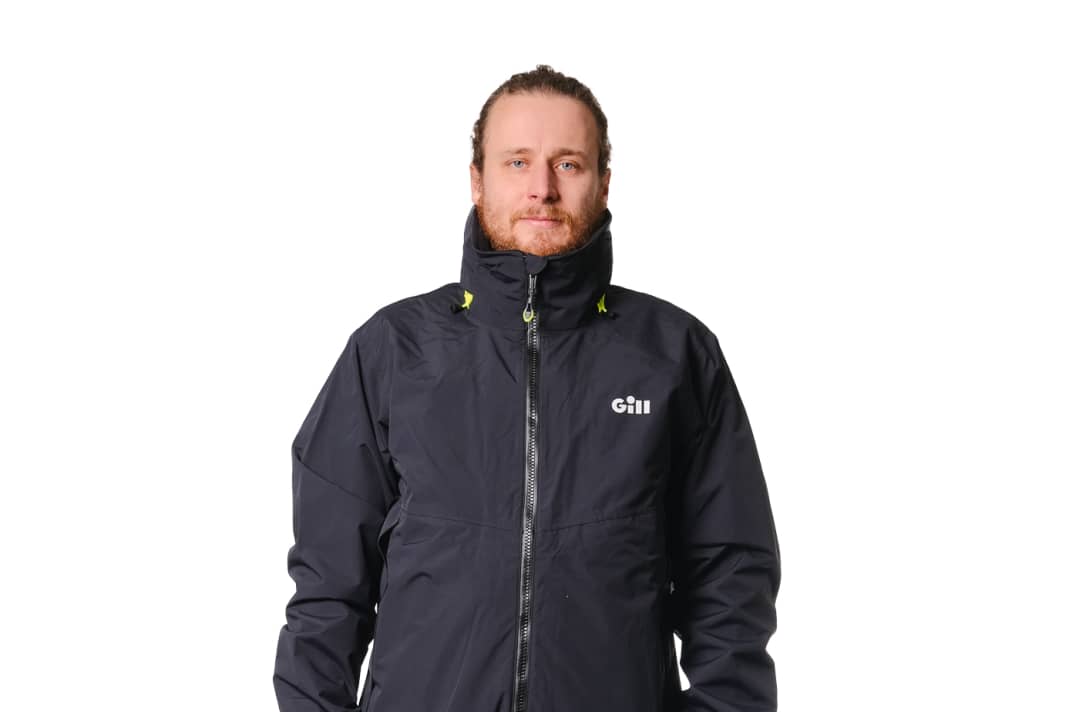



The new Gill oilskin fits well, and the hood also provides good visibility. However, it has very little overlap to the collar, which is just enough. The cuffs can be adjusted very easily. The trousers reach almost up to the neck
- + Easily adjustable cuffs
- + Trousers reach very high
- + Heat pockets on the jacket
- + Hood offers good visibility
- + Over 50 per cent recycled material
- - Few pockets
Valuation
- Distribution: www.gillmarine.de
- Price jacket (5): 260 Euro (5)
- Price trousers (5): 199 Euro (5)
- Wearing comfort (30): Good (25)
- Watertightness (40): Good (35)
- Material: Two-ply, Xplore
- Jacket weight in g (5): 890/926/906 (3)
- Weight of trousers in g (5): 870/932/887 (1)
- Extras (10): Few but practical pockets. Very well adjustable double cuffs (8)
- YACHT rating: Very good (82)
Values in brackets: maximum achievable score, actual score achieved
Helly Hansen Newport Coastal Jacket + Bib
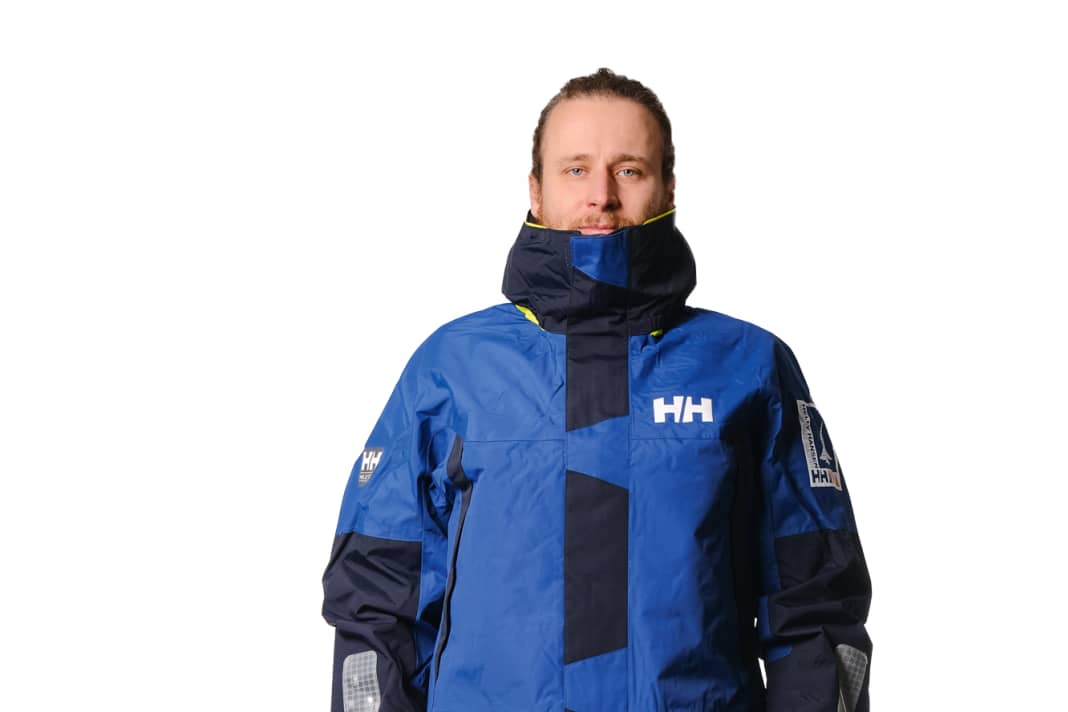



The Helly Hansen oilskin jacket has a retro nineties design. The functionality is good, the jacket is slightly larger. The manufacturer uses recycled fibres from marine waste and a PFC-free coating
- + Trousers fit close to the body
- + Hood offers good visibility
- + Double heat pockets
- + Over 50 per cent recycled material
- + Storm flaps in front of zips
- - Jacket quite wide
Valuation
- Distribution: www.hellyhansen.com
- Price jacket (5): 350 Euro (4)
- Price trousers (5): 230 Euro (5)
- Wearing comfort (30): Good (25)
- Watertightness (40): Very good (40)
- Material: Two-ply, Helly Tech
- Jacket weight in g (5): 1.040/1.136/1.081 (1)
- Weight of trousers in g (5):759/776/768 (3)
- Extras (10): Two heat pockets, good fit, double cuffs (10)
- YACHT rating: Very good (88)
Values in brackets: maximum achievable score, actual score achieved
Henri Lloyd M-Pro Jacket 2.0 + Salopette




The M-Pro 2.0 is very light and has no inner lining. It offers a very good fit, easily adjustable double cuffs and has plastic reinforcements on the knees and seat that do not absorb water
- + Very light
- + Very good freedom of movement
- + Plastic reinforcements
- + 100 per cent recycled fibres
- + Hood offers good visibility
- - High price
Valuation
- Distribution: www.henrilloyd.com
- Price jacket (5): 650 Euro (1)
- Price trousers (5): 500 Euro (2)
- Wearing comfort (30): Very good (30)
- Watertightness (40): Very good (40)
- Material: Three-ply, DRIpro
- Jacket weight in g (5): 675/695/681 (5)
- Weight of trousers in g (5):632/642/641 (3)
- Extras (10): Few usable pockets. Very large inside pocket. Breeze Clip (10)
- YACHT rating: Very good (91)
Values in brackets: maximum achievable score, actual score achieved
Musto BR2 Offshore Jacket 2.0 + Trousers
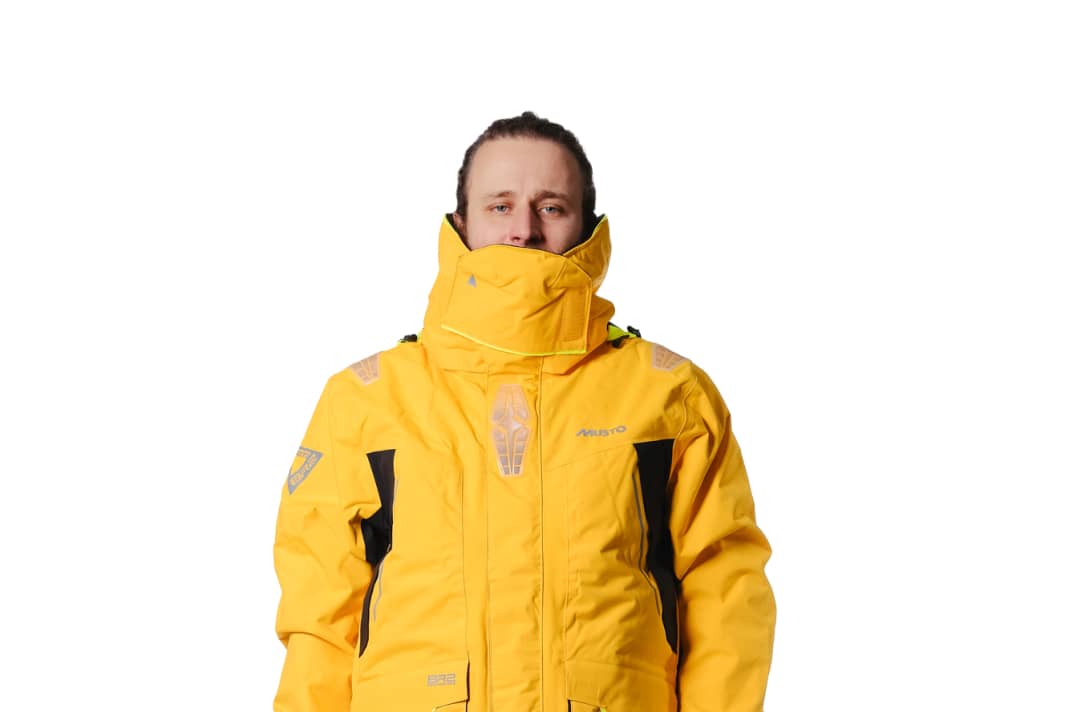



Recommended by Musto for coastal sailing. With a high collar and storm flap, typical offshore features. The hood doesn't turn so well, which is why it is less comfortable to wear. The cut offers good freedom of movement. Quite heavy
- + Many heat pockets
- + Very high collar with fleece
- + Adjustable braces with Velcro
- + Easily adjustable double cuffs
- - Processing has flaws
- - Hood does not turn well
Valuation
- Distribution: www.frisch.de
- Price jacket (5): 399 Euro (3)
- Price trousers (5): 319 Euro (4)
- Wearing comfort (30): Satisfactory (20)
- Watertightness (40): Very good (40)
- Material: PU membrane
- Jacket weight in g (5): 1.359/1.399/1.384 (2)
- Weight of trousers in g (5):972/988/988 (1)
- Extras (10): Double thermal pockets, two inside pockets, thermal pockets on the trousers (10)
- YACHT rating: Good (80)
Values in brackets: maximum achievable score, actual score achieved
Musto LPX Gore-Tex Jacket + Salopette
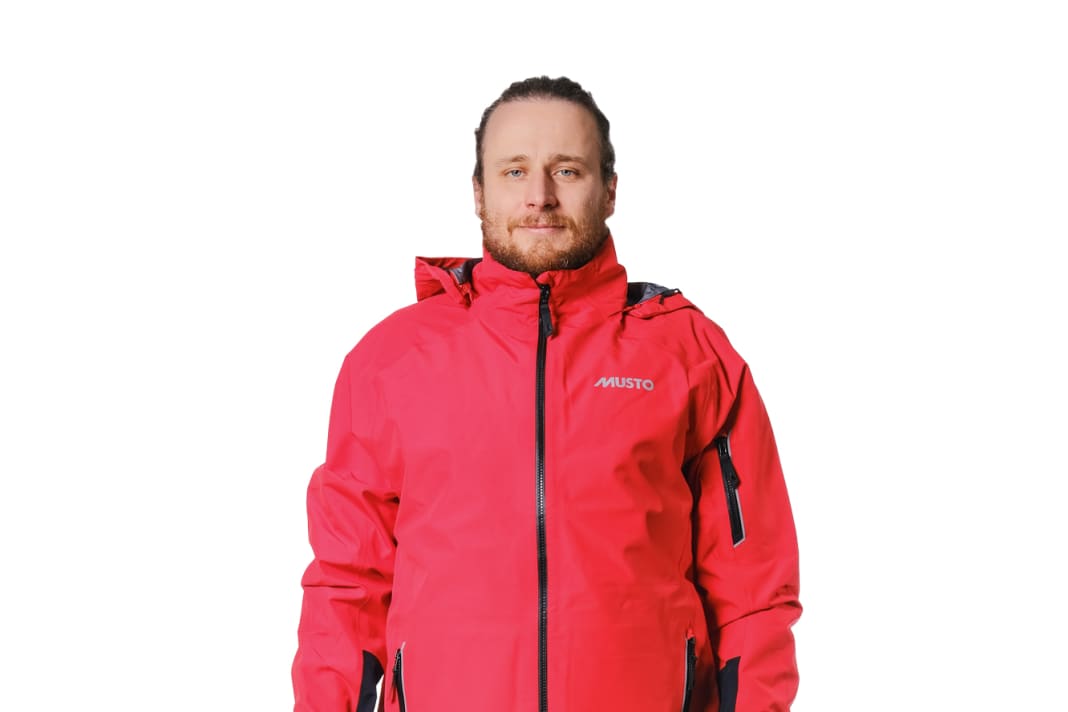



The LPX is super light, dries quickly and is highly breathable thanks to the Gore-Tex membrane. This makes it fundamentally different from the BR2, but a much higher quality oilskin. The hood offers good visibility
- + Very good freedom of movement
- + Lightweight material
- + Dries quickly
- + 100 per cent recycled polyester
- + Extra pocket on the upper arm
- - High price
Valuation
- Distribution: www.frisch.de
- Price jacket (5): 499 Euro (2)
- Price trousers (5): 479 Euro (3)
- Wearing comfort (30): Good (25)
- Watertightness (40): Very good (40)
- Material: Three-layer, Gore-Tex
- Jacket weight in g (5): 570/599/587 (3)
- Weight of trousers in g (5):671/679/678 (5)
- Extras (10): Detachable hood, pocket on the left upper arm. No inside pocket (8)
- YACHT rating: Very good (86)
Values in brackets: maximum achievable score, actual score achieved
North Sails Inshore Race Jacket + Trousers
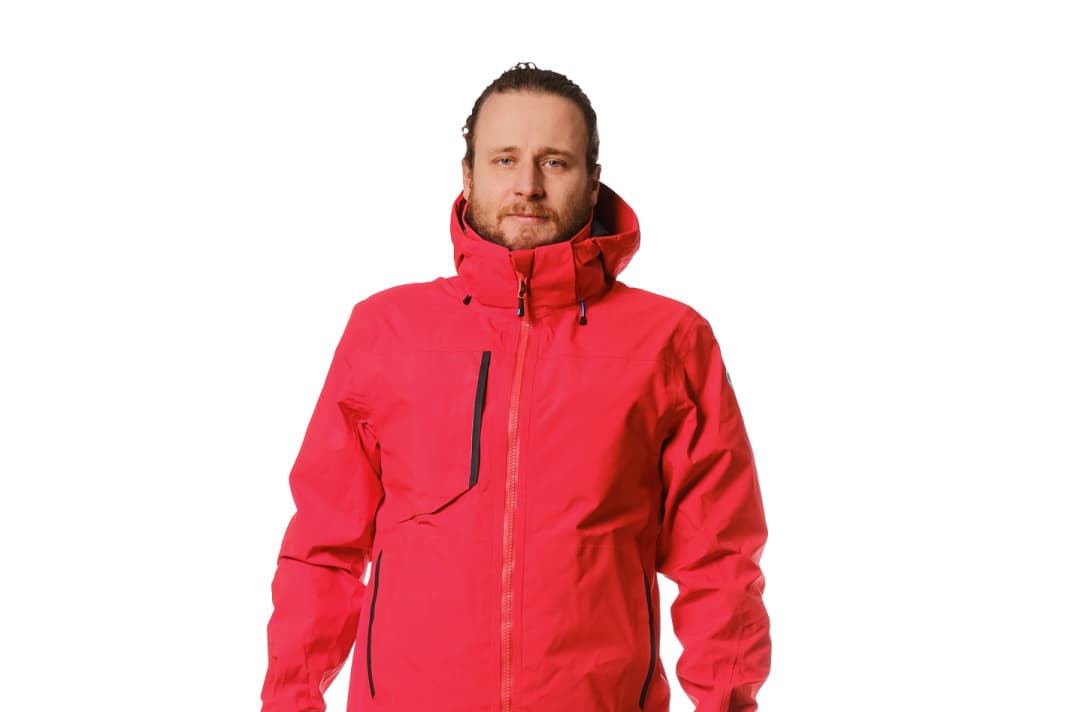



North does a lot of things differently with its oilskins: the TightWeave fabric on the surface is designed to absorb particularly little water, as are the reinforcements. The Gore-Tex membrane is top shelf, which is reflected in the price
- + Very light, good fit
- + Innovative shoulder strap adjustment
- + Reinforcements do not absorb water
- + bluesign sustainability seal
- - Hood does not turn well
- - High price
Valuation
- Distribution: www.northsails.com
- Price jacket (5): 625 Euro (1)
- Price trousers (5): 650 Euro (1)
- Wearing comfort (30): Satisfactory (20)
- Watertightness (40): Very good (40)
- Material: Three-layer, Gore-Tex
- Jacket weight in g (5): 577/588/583 (5)
- Weight of trousers in g (5):728/739/733 (5)
- Extras (10): Few, but easily usable pockets. Reinforcements made from 4DL, TightWeave (10)
- YACHT rating: Very good (82)
Values in brackets: maximum achievable score, actual score achieved
North Sails NSX Inshore Jacket + Trousers




The simpler oilskin from North still scores points with good freedom of movement, a very good fit and quick drying. Only the hood is not quite convincing either. The price is much more attractive
- + Very light, good fit
- + Innovative shoulder strap adjustment
- + 100 per cent recycled nylon
- + Dries quickly
- + Exciting alternative to Race in terms of price
- - Hood does not turn well
Valuation
- Distribution: www.northsails.com
- Price jacket (5): 300 Euro (4)
- Price trousers (5): 290 Euro (4)
- Wearing comfort (30): Satisfactory (20)
- Watertightness (40): Very good (40)
- Material: Three-ply, NSX
- Jacket weight in g (5): 629/698/639 (4)
- Weight of trousers in g (5):755/786/764 (4)
- Extras (10): Flush designed pocket on the leg. Cordura reinforcements, TightWeave (10)
- YACHT rating: Very good (86)
Values in brackets: maximum achievable score, actual score achieved
Patagonia Big Water Foul Weather Jacket
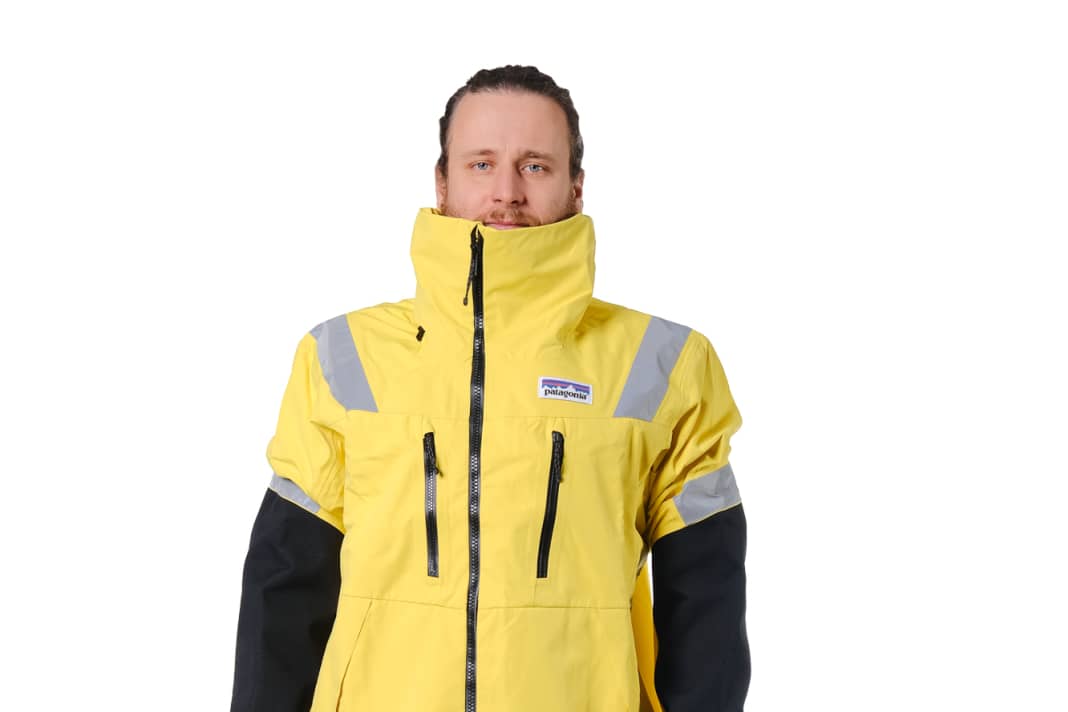


Patagonia is renowned in the outdoor clothing sector and known for sustainable production. Here too, all materials are 100 per cent recycled. The reinforcements are uncomfortable, the collar in combination with the hood is not tight
- + Well-fitting double cuffs
- + Large reflectors
- - Trousers not available
- - Arm reinforcements are hard and uncomfortable
- - Hood too short
- - Water ingress at the collar
Valuation
- Distribution: www.patagonia.com
- Price jacket (5): 650 Euro (1)
- Price trousers (5): 550 Euro, not available
- Wearing comfort (30): Sufficient (10)
- Watertightness (40): Poor (0)
- Material: Four-ply, H2No
- Jacket weight in g (5): 1.057/1.155/1.091 (1)
- Weight of trousers in g (5):k.A.
- Extras (10): Heat pockets plus waterproof breast pockets. Inner pocket without fastening (8)
- YACHT rating: Poor (20)
Values in brackets: maximum achievable score, actual score achieved
Typhoon Coastal TX-3 sailing jacket + sailing trousers
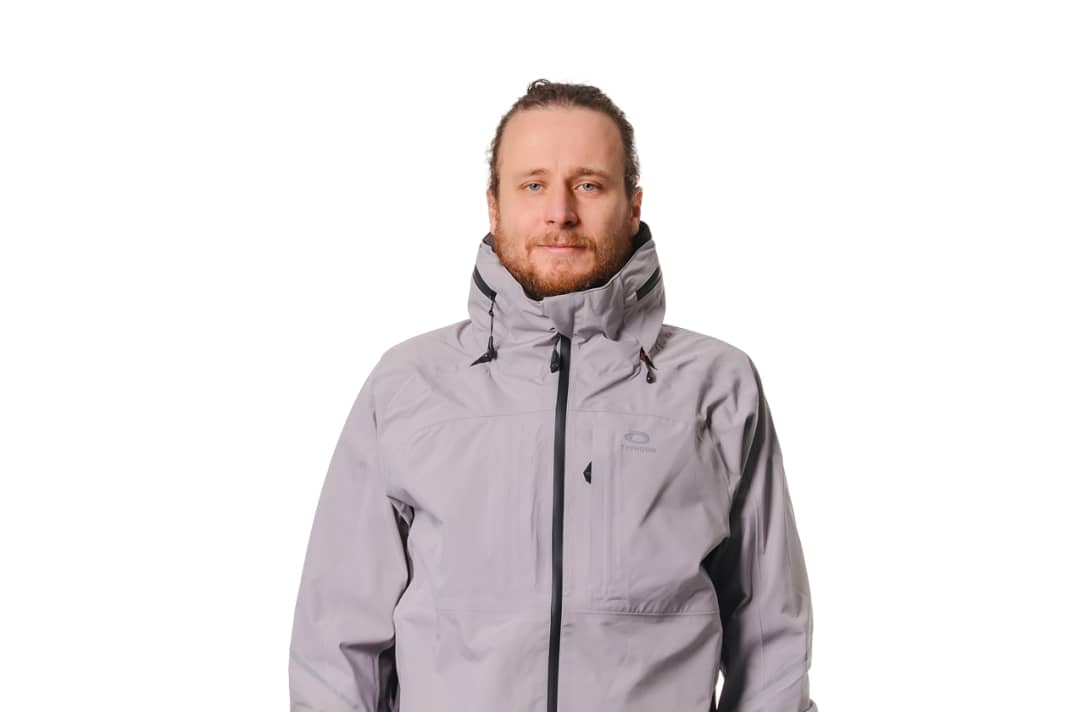



The TX-3 from Typhoon impresses with its extremely good fit, lightweight material and a hood that rotates very well. Unfortunately, the latter leaks at the seam, so water runs down the forehead into the collar. What a pity! The price is very attractive
- + Very good fit
- + Lightweight material
- + Fast drying
- + Many useful pockets
- + Attractive price
- - Hood leaking at the seam
Valuation
- Distribution: www.12seemeilen.de
- Price jacket (5): 170 Euro (5)
- Price trousers (5): 170 Euro (5)
- Wearing comfort (30): Very good (30)
- Watertightness (40): Poor (0)
- Material: Three-ply, TX-3 DWR
- Jacket weight in g (5): 563/612/573 (4)
- Weight of trousers in g (5):629/650/633 (5)
- Extras (10): Two large sealed trouser pockets plus one on the chest. Many pockets in the jacket (10)
- YACHT rating: Satisfactory (59)
Values in brackets: maximum achievable score, actual score achieved
Zhik CST500 jacket + salopette (YACHT test winner)
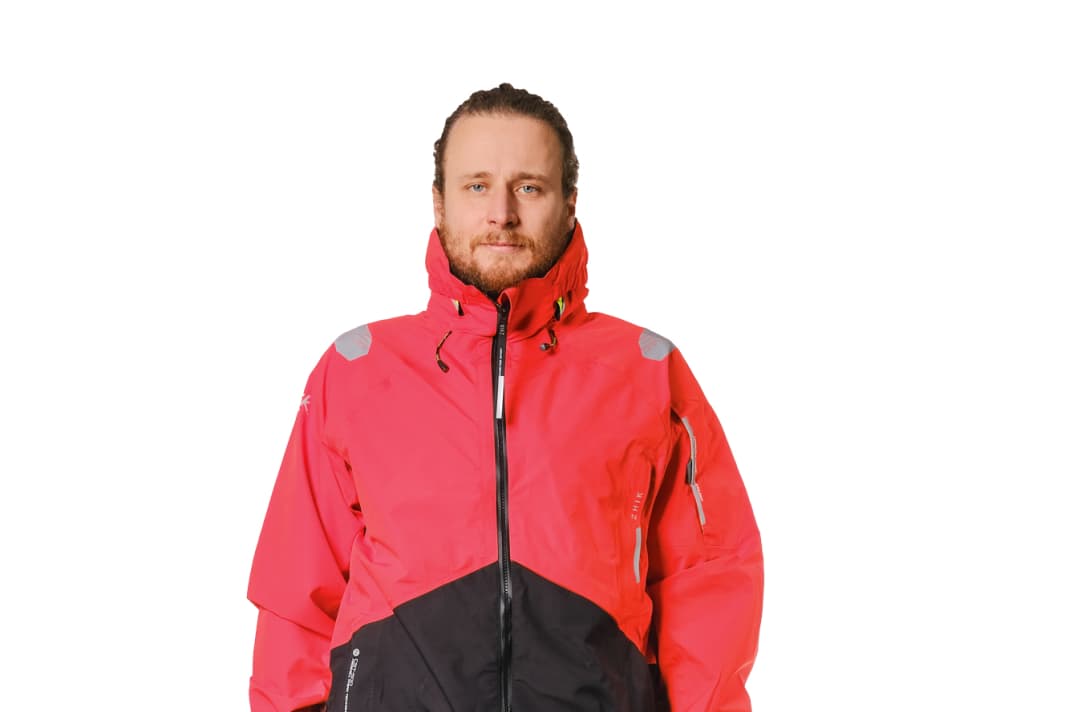



Very comfortable to wear, especially the hood, the lightweight material with excellent drying properties and very good results in simulated rain showers make the Zhik CST500 the test winner
- + Very good fit
- + Lightweight material
- + Fast drying
- + Hood turns very well
- + Zithane Lightweight on knees and buttocks
- - Quite high price
Valuation
- Distribution: www.frisch.de
- Price jacket (5): 480 Euro (3)
- Price trousers (5): 470 Euro (3)
- Wearing comfort (30): Very good (30))
- Watertightness (40): Very good (40
- Material: Three-ply, Aroshell
- Jacket weight in g (5): 586/643/593 (5)
- Weight of trousers in g (5):621/644/624 (5)
- Extras (10): Simple cuffs with stretch. Pocket on upper arm for PLB (10)
- YACHT rating: Very good (96)
Values in brackets: maximum achievable score, actual score achieved

